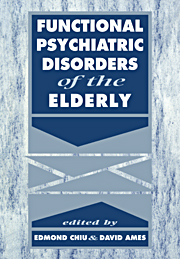Book contents
- Frontmatter
- Contents
- List of contributors
- Preface
- Introduction – A personal note
- Acknowledgement
- Part 1 Classification
- Part 2 General epidemiology
- Part 3 Neuroses
- Part 4 Affective disorders
- 7 The epidemiology of affective disorders in old age
- 8 The outcome of depressive illness in old age
- 9 Pseudodementia in geriatric depression
- 10 Depression in nursing and residential homes
- 11 Depression in primary care settings
- 12 Treatment of depression in the elderly
- 13 Mania in late life: conceptual and clinical issues
- 14 Suicide in the elderly
- Part 5 Psychosexual disorders
- Part 6 Substance use and abuse
- Part 7 Schizophrenia and related psychoses
- Part 8 Psychological, biological and medical issues
- Part 9 Treatment methods
- Part 10 Conclusion
- Index
13 - Mania in late life: conceptual and clinical issues
from Part 4 - Affective disorders
Published online by Cambridge University Press: 13 November 2009
- Frontmatter
- Contents
- List of contributors
- Preface
- Introduction – A personal note
- Acknowledgement
- Part 1 Classification
- Part 2 General epidemiology
- Part 3 Neuroses
- Part 4 Affective disorders
- 7 The epidemiology of affective disorders in old age
- 8 The outcome of depressive illness in old age
- 9 Pseudodementia in geriatric depression
- 10 Depression in nursing and residential homes
- 11 Depression in primary care settings
- 12 Treatment of depression in the elderly
- 13 Mania in late life: conceptual and clinical issues
- 14 Suicide in the elderly
- Part 5 Psychosexual disorders
- Part 6 Substance use and abuse
- Part 7 Schizophrenia and related psychoses
- Part 8 Psychological, biological and medical issues
- Part 9 Treatment methods
- Part 10 Conclusion
- Index
Summary
Conceptual issues and the classification of affective disorders
The investigation of mania in old age invites a reconsideration of the fundamental nature of affective illness. Studying an elderly cohort offers the opportunity to examine a prolonged longitudinal course of the illness as well as focusing attention on the role of cerebral-organic factors. Recent studies of mania in old age have questioned the legitimacy of separating unipolar from bipolar disorders (Shulman & Post, 1980; Snowdon, 1991). Many unipolar depressives are apparently ‘converted’ into bipolars in old age after a latency of many years and numerous depressive episodes (Stone, 1989; Snowdon, 1991). This is also true of many young unipolar patients. Akiskal et al. (1983) found that 20% of young depressed patients with no prior history of mania became manic after an average 3-year prospective follow-up. Indeed, most clinicians are aware of subtle hypomanic shifts in ‘unipolar’ depressed and dysthymic patients. Because the study of the elderly lends itself to a retrospective cohort analysis, the longitudinal course of affective disorders is more readily revealed.
The notion of a spectrum of affective disorder as described by Akiskal (1983) is appealing. Milder expressions of the disorder include temperaments such as dysthymic, or hyperthymic. The range of expression continues from unipolar single episode to recurrent unipolar, bipolar II with mild hypomania to bipolar I with full-blown manic episodes. In this conceptual framework, mania is considered a more severe form of the disorder.
- Type
- Chapter
- Information
- Functional Psychiatric Disorders of the Elderly , pp. 212 - 220Publisher: Cambridge University PressPrint publication year: 1994



